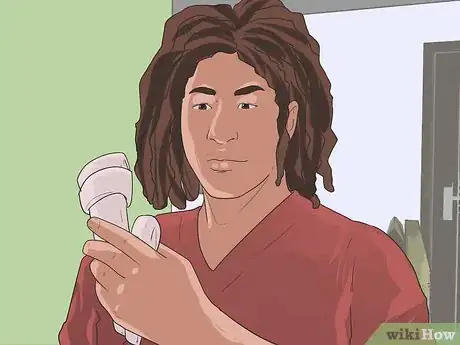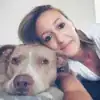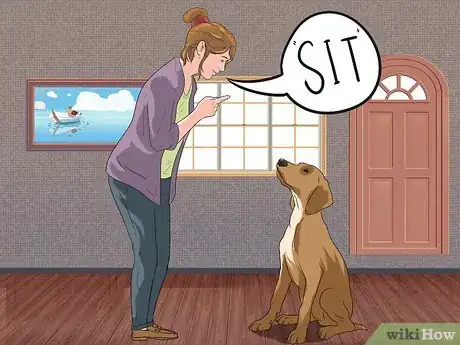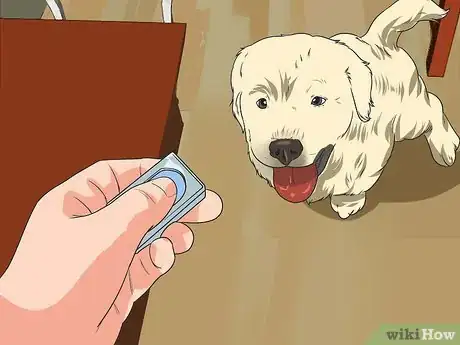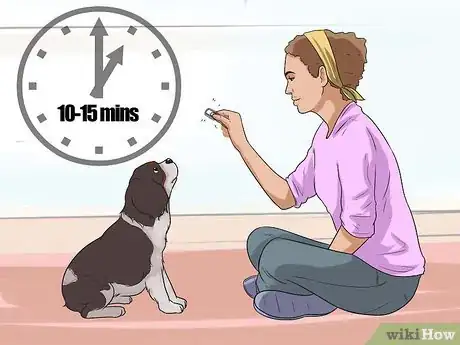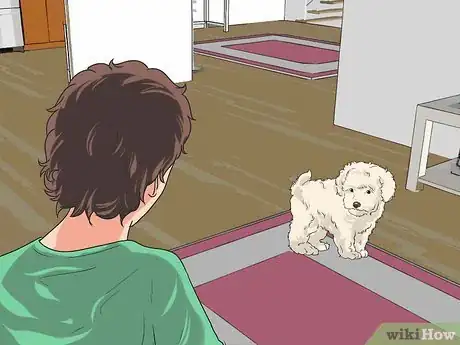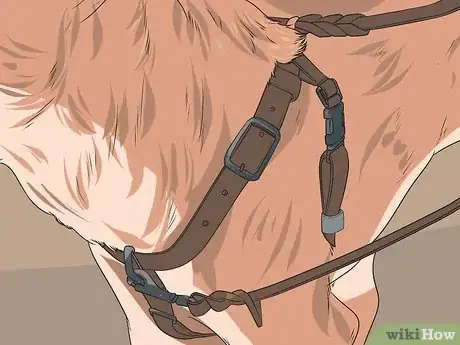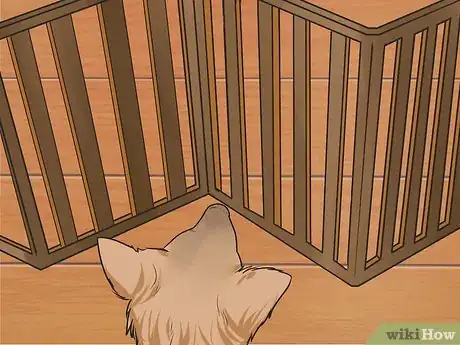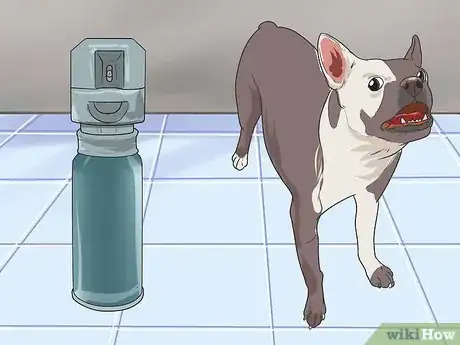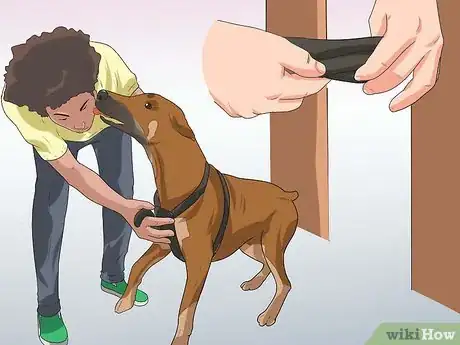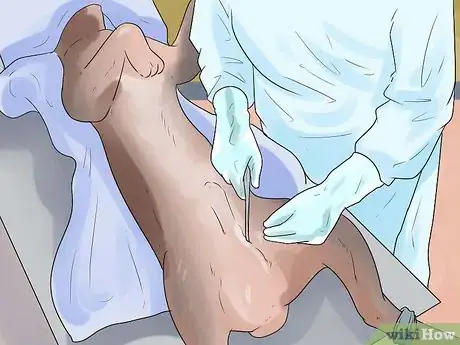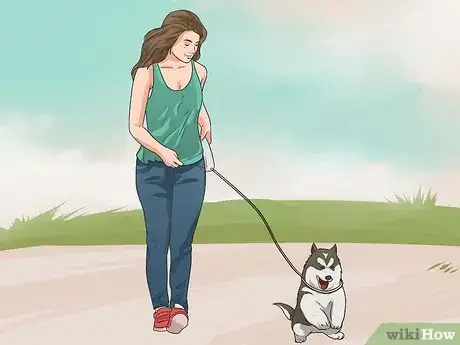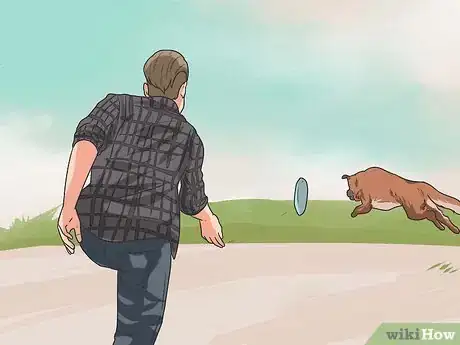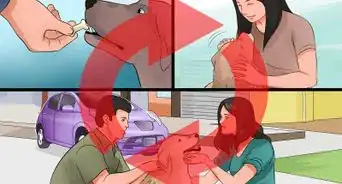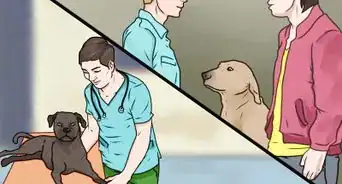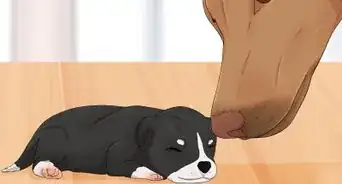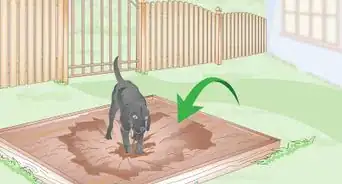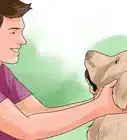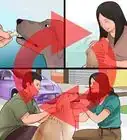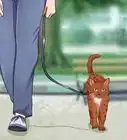This article was co-authored by Jessica Powell. Jessica is a Certified Professional Dog Trainer and the Owner of Proud Paws Dog Training, a small business offering private coaching and in-home dog training services to dog parents across the San Fernando Valley of Los Angeles, California. With nearly ten years of experience, she has extensive knowledge and experience in dog behavior, effective communication techniques, animal welfare, manners training, behavioral modification, and enrichment. Jessica holds a Bachelor of Science degree in Animal Management and is also an experienced shelter professional.
This article has been viewed 114,112 times.
Having a dog that escapes from the house can be both irritating for you and dangerous for your dog. Training your dog not to run out of the house is an important step toward instilling obedience in your canine friend. Teaching your dog to stay or sit and limiting your dog’s domain are the easiest fixes for curing a “dashing dog.” Prevent your dog from dashing in the first place by giving it plenty of exercise and attention.
Steps
Teaching Your Dog to Sit or Stay
-
1Look for and reward natural sitting behavior.[1] If you walk into a room and your dog sits, then your job is half done. Reward your dog when it sits, even if you don’t issue the command to sit. Give your dog a treat when it sits in front of you.
-
2Begin issuing the “sit” command. After a few days of rewarding the dog for sitting naturally, begin issuing the “sit” command before giving a treat. Get on the dog’s level and hold a doggie treat enclosed in your hand a few inches from his nose. Bring it up and toward him slowly. Your dog will lower itself back onto its butt. When its butt hits the floor, reward your dog with a treat.Advertisement
-
3Reinforce sitting behavior with a clicker.[2] [3] A clicker is a small device which makes a clicking sound when pressed. Click when your dog sits (when his butt hits the ground). The clicker tells the dog he has completed the behavior you asked for correctly. Reward about five seconds after you clicked. This will allow the dog to make the connection between the click and the reward, but not with the motion of your hand toward the treat or another movement. The dog will quickly learn that the clicker sound means he has completed a behavior correctly, and can expect a reward.
- If your dog has already been trained with the clicker to engage in a different behavior, you might confuse the dog if you try to retrain it to sit instead of engage in its original behavior.
-
4Train your dog to sit or stay when the door is open.[4] [5] If the door is open, or about to be opened, getting your dog to remain seated can be a challenge. Incorporate an open-door phase into your training sessions. Teach your dog to stay seated as you back away towards the door.
- Put your dog far away from (but within eyesight of) the door. If your dog starts moving after being seated, put your hand up and say sharply “Stop!” Re-seat your dog in its original spot and repeat the exercise.
- If your dog has difficulty remaining seated, get a friend to help your dog stay seated while you can open and close the door.
- When your dog is able to remain seated despite you opening and closing the door, give it a treat (even if it took help to keep him stationary). Get in the habit of giving your dog a treat each time it is able to remain seated when the door opens.
- To prevent your dog from running out when you come home, repeat this exercise but enlist aid from a helper who opens the door from the outside. This way, your dog will know to stay seated when you come in.
-
5Be patient when training your dog. Practice for 10-15 minutes in at least three different sessions each day for about two weeks. Different dogs learn at different rates. Do not be discouraged if your dog seems to be slow to learn how sitting works. On the other hand, do not be quick to assume that your dog has mastered sitting just because in one session he or she seemed to sit with every command during that session. Stick with it and stay positive. Your dog will eventually learn to sit.
-
6Keep your dog focused. Like people, dogs can’t stay focused for periods which are excessively long. If your dog loses interest during the training session, your training may have gone on for too long. Let your dog go out before you begin the training so that he won’t have to relieve himself during the training.
- Do not train your dog in the presence of guests or other distractions.
- Issue the command to sit every time you or someone in the house opens the door.
- Give your dog a treat when it sits.
- Even after training, keep an eye on your dog. Sometimes the excitement of an open door or a new person can inspire him or her to dash outside. When entering your home, open the door slowly and come in quickly, staying alert for potential dog movement.
Limiting Your Dog’s Domain
-
1Keep your dog in only certain areas of the house. For instance, if your house has a small anteroom between the house and the door that leads outside, keep your dog out of it. Alternately, if the dog tends to bolt through certain doors, keep your dog out of the room with that door. Using baby gates (low gates meant to keep babies from crawling about the house) are useful for keep smaller dogs out of certain zones. Finally, if all else fails, enclose your dog in a room before you go in or out of the house. Keep the room stocked with toys, chew bones, and a comfy dog bed to keep doggie happy.
-
2Catch the dog on its way out. Attach a long dragline -- a lightweight leash -- to your dog’s collar.[6] Let your dog get used to it and drag it behind them while wandering around the house. If your dog runs out the door when you open it, quickly close the door while part of the dragline passes through the door, catching it between the door and the jamb. This way, your dog will be stuck outside but immobilized. Wait 30 seconds, then grab the portion of the leash on your side of the door before opening it. When your dog comes back to the house, praise it effusively.
- When your dog continues to run outside, increase the time it spends outside by 30 seconds. For instance, the second time it runs out, catch its leash in the door again and wait 60 seconds before bringing it back in. Wait 90 seconds on the third escape attempt, and so on.
- Be careful not to catch your dog’s tail in the door when closing it during the escape.
- If you are coordinated and quick enough, you can simply step on the length of leash dragging behind your dog instead of closing the door on it as your dog exits.
-
3Erect a fence. If your dog does run out of your house, the best way to prevent a full-on escape is to fence your yard.[7] This is often only a viable choice for the backyard, though small front yards can be easily enclosed with tasteful white picket fences. Install a smaller fence for a small dog and a higher fence for a big dog. Note that big dogs can jump very high, so twice the size may not be enough.
-
4Try a pet-proofing barrier or spray. Pet barriers are small devices which emit noise when your dog approaches. Triggered by a wireless device attached to the dog’s collar, the barrier will scare your dog away from the door. If your dog remains undeterred from approaching the door, he or she will receive a small static shock from the collar intended to keep them inside. The shock is harmless and in time, your dog will avoid approaching the door altogether.
- Pet-proof sprays serve a similar purpose, though they have a different design. Spray cans are battery-operated and should be placed near the door you do not want your dog to run out of. Switch the spray can on. When your doggie approaches the door, the device will emit a harmless spray whenever your pet approaches the door. Be sure to turn the device off when you’re not expecting to open the door through which the dog might disappear.[8]
- Both pet sprays and barriers can prevent your dog from bolting when you or someone else is coming into the house. Set the spray or barrier before you exit the house so that when you come back, your dog will not run past you and escape.
-
5Tether your dog before you go in or out of the house. Tie its leash to a solid object so that the dog will not escape. Tying the leash to the arm of a sofa or the base of a heavy dining table are good choices. You could also, of course, hold the leash in your hand when someone comes in or goes out. In time, your dog will come to understand that it cannot dash outside when a door opens.[9]
- Tethering your dog should be a last resort since it can be dangerous or detrimental for your dog.
- Try to avoid tethering your dog when you go out of the house for long periods. Your dog should be able to move about, access its food and water, and play with its toys when alone in the house.[10]
- Do not tether your dog near stairs. If your dog tries to jump down the stairs it could hang itself.
Reducing the Temptation to Escape
-
1Neuter or spay your dog.[11] Often, dogs escape from the house because they aren't neutered/spayed. In their attempts to mate, they will make a run for the door, and from there to a dog of the opposite sex. This motive is especially powerful in male dogs. Talk to your vet about neutering or spaying your pet. The procedure is very safe and relatively inexpensive.
-
2Give your dog a lot of exercise.[12] Tired dogs are less likely to want to escape the house. Make sure you exercise your dog every day. You can either give your dog free reign for fifteen to twenty minutes in the backyard or take your doggie for a walk. If your dogs likes to play fetch or catch the Frisbee in an enclosed area, that provides a good source of exercise as well. Dogs of all sizes and breeds should spend some time outside each day, weather permitting.
-
3Keep your dog happy and entertained. Bored dogs may be driven outside in a search for amusement. Keep your dog engaged and content by playing lots of games with it, teaching it tricks, and generally paying attention to your dog. Let your doggie know it is loved and cared for. When you come home, give it a hug and pat it on the head. Rub its belly if it rolls over for you. Set aside time in your schedule for you and your dog to bond.
Expert Q&A
-
QuestionHow do you train your dog to not run out of the house?
 Osama MaghawriOsama Maghawri is a Dog Trainer and Founder of OneStopK9, a dog training service in Miami, Florida. Osama utilizes balanced training methods to teach communication between owners and dogs. He specializes in basic obedience and behavioral issues such as resource guarding, fear-based aggression, and leash reactivity. Osama also helps owners understand the behaviors of their breed and how to continue training on their own in the future.
Osama MaghawriOsama Maghawri is a Dog Trainer and Founder of OneStopK9, a dog training service in Miami, Florida. Osama utilizes balanced training methods to teach communication between owners and dogs. He specializes in basic obedience and behavioral issues such as resource guarding, fear-based aggression, and leash reactivity. Osama also helps owners understand the behaviors of their breed and how to continue training on their own in the future.
Professional Dog Trainer I suggest you put a leash on your dog and then open the door. While holding the leash, wait for your dog to settle and sit down. Once they've done this, reward them and give them a command like "free" or "okay" to let them know they can move again. Then, keep practicing this behavior until they know to not run through the door.
I suggest you put a leash on your dog and then open the door. While holding the leash, wait for your dog to settle and sit down. Once they've done this, reward them and give them a command like "free" or "okay" to let them know they can move again. Then, keep practicing this behavior until they know to not run through the door. -
QuestionHow do I train my dog to come back when she wanders out of the yard?
 Community AnswerUse treats to cajole your dog into returning to you. Make a kissing sound and call its name when offering the treat. After several times of doing this, your dog will associate its name and the sound with the behavior of returning to you and getting a treat. Continue to provide a treat to your dog when it returns or it will slowly lose the association between you calling her and her decision to return.
Community AnswerUse treats to cajole your dog into returning to you. Make a kissing sound and call its name when offering the treat. After several times of doing this, your dog will associate its name and the sound with the behavior of returning to you and getting a treat. Continue to provide a treat to your dog when it returns or it will slowly lose the association between you calling her and her decision to return. -
QuestionCan I train my dog not to run out of the house in just one week?
 Community AnswerIt is possible to do this in under a week. However, if your dog doesn't learn in under a week, be patient and keep training. Every dog learns at a different pace.
Community AnswerIt is possible to do this in under a week. However, if your dog doesn't learn in under a week, be patient and keep training. Every dog learns at a different pace.
Warnings
- Don't over-exercise your dog! An exhausted dog is more likely to be injured.⧼thumbs_response⧽
References
- ↑ Jessica Powell. Certified Professional Dog Trainer. Expert Interview. 5 October 2021.
- ↑ Jessica Powell. Certified Professional Dog Trainer. Expert Interview. 5 October 2021.
- ↑ Osama Maghawri. Professional Dog Trainer. Expert Interview. 9 September 2020.
- ↑ Jessica Powell. Certified Professional Dog Trainer. Expert Interview. 5 October 2021.
- ↑ Osama Maghawri. Professional Dog Trainer. Expert Interview. 9 September 2020.
- ↑ Jessica Powell. Certified Professional Dog Trainer. Expert Interview. 5 October 2021.
- ↑ Jessica Powell. Certified Professional Dog Trainer. Expert Interview. 5 October 2021.
- ↑ http://store.petsafe.net/ssscat-spray-deterrent
- ↑ http://www.vetstreet.com/our-pet-experts/can-i-teach-my-dog-not-to-dash-out-the-door?page=2
- ↑ http://www.humanesociety.org/issues/chaining_tethering/facts/chaining_tethering_facts.html
- ↑ http://www.vetstreet.com/our-pet-experts/can-i-teach-my-dog-not-to-dash-out-the-door
- ↑ Jessica Powell. Certified Professional Dog Trainer. Expert Interview. 5 October 2021.
About This Article
To train your dog from running out of your house, start by teaching it the "sit" command so it will sit whenever you need to open the door. In order to do this, hold a treat in your hand. Then, hold your hand a few inches above your dog’s nose, which will make your dog lower itself onto its butt. When your dog sits, reward the behavior by giving it the treat as you say “sit.” Along with training, prevent your dog from running out of the house by using a baby gate to keep it away from the front door. You should also give it lots of exercise during the day so it doesn't feel the urge to run. For more tips from our Veterinary co-author, including how to keep your dog focused during training sessions, keep reading!
